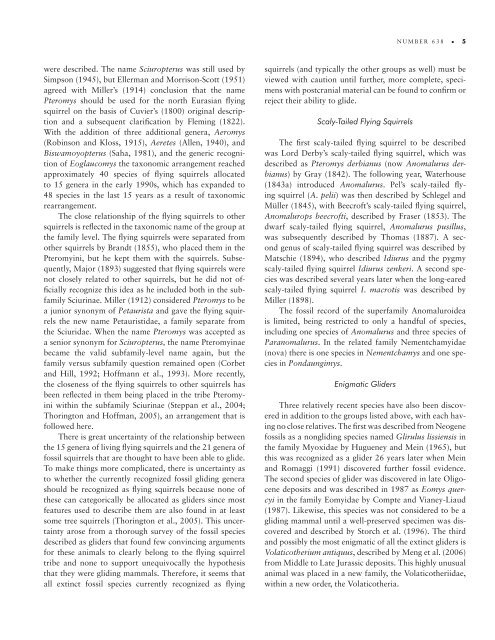Gliding Mammals: Taxonomy of Living and Extinct Species
Gliding Mammals: Taxonomy of Living and Extinct Species
Gliding Mammals: Taxonomy of Living and Extinct Species
Create successful ePaper yourself
Turn your PDF publications into a flip-book with our unique Google optimized e-Paper software.
were described. The name Sciuropterus was still used by<br />
Simpson (1945), but Ellerman <strong>and</strong> Morrison- Scott (1951)<br />
agreed with Miller’s (1914) conclusion that the name<br />
Pteromys should be used for the north Eurasian flying<br />
squirrel on the basis <strong>of</strong> Cuvier’s (1800) original description<br />
<strong>and</strong> a subsequent clarification by Fleming (1822).<br />
With the addition <strong>of</strong> three additional genera, Aeromys<br />
(Robinson <strong>and</strong> Kloss, 1915), Aeretes (Allen, 1940), <strong>and</strong><br />
Biswamoyopterus (Saha, 1981), <strong>and</strong> the generic recognition<br />
<strong>of</strong> Eoglaucomys the taxonomic arrangement reached<br />
approximately 40 species <strong>of</strong> flying squirrels allocated<br />
to 15 genera in the early 1990s, which has exp<strong>and</strong>ed to<br />
48 species in the last 15 years as a result <strong>of</strong> taxonomic<br />
rearrangement.<br />
The close relationship <strong>of</strong> the flying squirrels to other<br />
squirrels is reflected in the taxonomic name <strong>of</strong> the group at<br />
the family level. The flying squirrels were separated from<br />
other squirrels by Br<strong>and</strong>t (1855), who placed them in the<br />
Pteromyini, but he kept them with the squirrels. Subsequently,<br />
Major (1893) suggested that flying squirrels were<br />
not closely related to other squirrels, but he did not <strong>of</strong>ficially<br />
recognize this idea as he included both in the subfamily<br />
Sciurinae. Miller (1912) considered Pteromys to be<br />
a junior synonym <strong>of</strong> Petaurista <strong>and</strong> gave the flying squirrels<br />
the new name Petauristidae, a family separate from<br />
the Sciuridae. When the name Pteromys was accepted as<br />
a senior synonym for Sciuropterus, the name Pteromyinae<br />
became the valid subfamily- level name again, but the<br />
family versus subfamily question remained open (Corbet<br />
<strong>and</strong> Hill, 1992; H<strong>of</strong>fmann et al., 1993). More recently,<br />
the closeness <strong>of</strong> the flying squirrels to other squirrels has<br />
been reflected in them being placed in the tribe Pteromyini<br />
within the subfamily Sciurinae (Steppan et al., 2004;<br />
Thorington <strong>and</strong> H<strong>of</strong>fman, 2005), an arrangement that is<br />
followed here.<br />
There is great uncertainty <strong>of</strong> the relationship between<br />
the 15 genera <strong>of</strong> living flying squirrels <strong>and</strong> the 21 genera <strong>of</strong><br />
fossil squirrels that are thought to have been able to glide.<br />
To make things more complicated, there is uncertainty as<br />
to whether the currently recognized fossil gliding genera<br />
should be recognized as flying squirrels because none <strong>of</strong><br />
these can categorically be allocated as gliders since most<br />
features used to describe them are also found in at least<br />
some tree squirrels (Thorington et al., 2005). This uncertainty<br />
arose from a thorough survey <strong>of</strong> the fossil species<br />
described as gliders that found few convincing arguments<br />
for these animals to clearly belong to the flying squirrel<br />
tribe <strong>and</strong> none to support unequivocally the hypothesis<br />
that they were gliding mammals. Therefore, it seems that<br />
all extinct fossil species currently recognized as flying<br />
NUMBER 638 • 5<br />
squirrels (<strong>and</strong> typically the other groups as well) must be<br />
viewed with caution until further, more complete, specimens<br />
with postcranial material can be found to confirm or<br />
reject their ability to glide.<br />
Scaly- Tailed Flying Squirrels<br />
The first scaly- tailed flying squirrel to be described<br />
was Lord Derby’s scaly- tailed flying squirrel, which was<br />
described as Pteromys derbianus (now Anomalurus derbianus)<br />
by Gray (1842). The following year, Waterhouse<br />
(1843a) introduced Anomalurus. Pel’s scaly- tailed flying<br />
squirrel (A. pelii) was then described by Schlegel <strong>and</strong><br />
Müller (1845), with Beecr<strong>of</strong>t’s scaly- tailed flying squirrel,<br />
Anomalurops beecr<strong>of</strong>ti, described by Fraser (1853). The<br />
dwarf scaly- tailed flying squirrel, Anomalurus pusillus,<br />
was subsequently described by Thomas (1887). A second<br />
genus <strong>of</strong> scaly- tailed flying squirrel was described by<br />
Matschie (1894), who described Idiurus <strong>and</strong> the pygmy<br />
scaly- tailed flying squirrel Idiurus zenkeri. A second species<br />
was described several years later when the long- eared<br />
scaly- tailed flying squirrel I. macrotis was described by<br />
Miller (1898).<br />
The fossil record <strong>of</strong> the superfamily Anomaluroidea<br />
is limited, being restricted to only a h<strong>and</strong>ful <strong>of</strong> species,<br />
including one species <strong>of</strong> Anomalurus <strong>and</strong> three species <strong>of</strong><br />
Paranomalurus. In the related family Nementchamyidae<br />
(nova) there is one species in Nementchamys <strong>and</strong> one species<br />
in Pondaungimys.<br />
Enigmatic Gliders<br />
Three relatively recent species have also been discovered<br />
in addition to the groups listed above, with each having<br />
no close relatives. The first was described from Neogene<br />
fossils as a nongliding species named Glirulus lissiensis in<br />
the family Myoxidae by Hugueney <strong>and</strong> Mein (1965), but<br />
this was recognized as a glider 26 years later when Mein<br />
<strong>and</strong> Romaggi (1991) discovered further fossil evidence.<br />
The second species <strong>of</strong> glider was discovered in late Oligocene<br />
deposits <strong>and</strong> was described in 1987 as Eomys quercyi<br />
in the family Eomyidae by Compte <strong>and</strong> Vianey- Liaud<br />
(1987). Likewise, this species was not considered to be a<br />
gliding mammal until a well- preserved specimen was discovered<br />
<strong>and</strong> described by Storch et al. (1996). The third<br />
<strong>and</strong> possibly the most enigmatic <strong>of</strong> all the extinct gliders is<br />
Volaticotherium antiquus, described by Meng et al. (2006)<br />
from Middle to Late Jurassic deposits. This highly unusual<br />
animal was placed in a new family, the Volaticotheriidae,<br />
within a new order, the Volaticotheria.

















